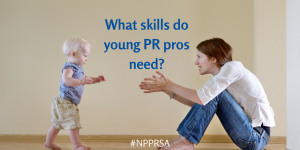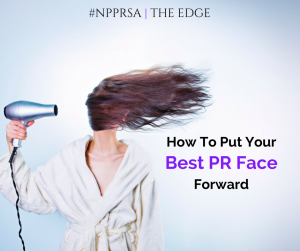Editor’s note: This is the second post in our monthly #ThrowbackThursday series, which features a prominent, successful PR pro taking a look back and sharing tips from his/her days as a new pro.
Earlier this week, we shared five skills young pros need to excel in the PR world, and as many noticed, digital knowledge was at the top of that list.
 Today’s #ThrowbackThursday guest, Christopher Penn, pretty much wrote the book on digital PR. (And by “wrote the book,” we mean authored three best sellers.)
Today’s #ThrowbackThursday guest, Christopher Penn, pretty much wrote the book on digital PR. (And by “wrote the book,” we mean authored three best sellers.)
He’s the vice president of marketing technology at SHIFT Communications, co-founder of PodCamp New Media Community Conference and co-host of the Marketing Over Coffee podcast. Christopher has been named one of the top 50 most influential people in social media and digital marketing by Forbes multiple times, and he was named the PR News 2014 Agency Professional of the Year.
So, yeah. When it comes to integrated marketing communications, Christopher Penn is kind of a big deal. Now, let’s take a walk through his PR memory lane on this #ThrowbackThursday!
Question 1: You didn’t start off in PR right out of school. How did you get started in the industry?
It’s funny you mention that. I’ve been a marketer for years and years. The middle of the funnel – lead generation – was really my area of expertise. I could squeeze leads out of nearly any audience with tried and true marketing tactics.
But I ran into a problem: where does the audience come from?
As a marketer, you usually just buy it, with ads or list buys. That gets expensive. In 2012, I was talking to a good friend and agency owner, Mitch Joel, and he said that I needed to understand the agency world.
After that conversation, I reached out to longtime acquaintance Todd Defren, co-founder of SHIFT Communications, and said hey, let’s trade. You teach me about the top of the funnel and how PR works, and I’ll bring the middle of the funnel expertise to your clients. That started a beautiful relationship!
Question 2: Right out of college, what would you say are the most important skills new PR pros should possess?
The Ability to Write
Writing is at the heart of modern marketing and PR. Everything begins with writing, from sticky notes on your desk to 90,000 word books to screenplays for YouTube videos. Even great speaking leverages your ability to skillfully choose words. The problem is, most people aren’t great writers. Most people are average or slightly below average writers who can’t communicate with clarity.
I recommend that every student – and every PR pro – become familiar with tools like SlickWrite and Hemingway. While these tools cannot fix problems with structure, logical flow, or facts, they can identify basic flaws in writing. See this post on up-cycling content for a bit more on these tools.
The Ability to Do Deep Analysis
Statistics and mathematics are core skills for today’s PR pro. I know, I know, you got into PR to avoid math. Bad news: everything has math now. You must have the ability to take data, visualize it, analyze it, and turn it into insights and strategies.
Many students take courses with tools like SPSS and R; when they leave university life, those skills quickly atrophy. Don’t permit that to happen. Download data sets from public sources like data.gov to keep your data analysis skills strong. Practice, improve, and expand your data analysis toolkit.
If you’re facing data analysis challenges, I also recommend my latest book, Marketing Blue Belt.
The Ability to Be Creative
Creativity is one skill area that gets systematically beaten out of you by school and work. The ability to be creative hinges on your inputs, on how much useful stuff is in your brain that you can draw on at any given time. If all you’ve got in your head is junk, then all you’ll produce is junk. (Click to Tweet!) Feed your brain, especially after leaving an academic environment!
The more useful, usable information your mind has to work with, the more creative you can be. (this is also the basis for my previous book, Marketing Red Belt).
Question 3: Many new pros know they need to learn digital marketing skills, but they don’t know where to start. Can you share some tips on how new pros can learn on their own?
Learn by reading. There are great books out there like the Portable MBA on Marketing that can give you a solid foundation. If you’re in a hurry, I wrote a Cliffs Notes style book on marketing called Marketing White Belt.
Question 4: What were some of the pivotal teachings or experiences from your past that helped you become the PR pro you are today?
The biggest lessons come from the martial arts. One of the tenets of the art I practice is “keep going!”. It’s an admonition to never get comfortable, to never believe that you’ve won, and to keep learning.
One of my teachers, Ken Savage, has a great expression, “Teacher for now, student for life”. As we rise up in the ranks of our organizations, we tend to forget to keep learning. We get entrenched. We don’t budget time for learning – and we fall behind. Our organizations fall behind. Don’t let that happen – keep going!
Question 5: If you could go back in time and give advice to yourself during your first year in PR, what would you say?
I would advise myself to buy Apple stock before the 7-1 split last summer. Investing 100 shares in Apple when I joined SHIFT would have cost $12,400. Today that same investment would be worth $87,493.
More about Christopher:
Christopher S. Penn has been featured as a recognized authority in many books, publications such as the Wall Street Journal, Washington Post, New York Times, BusinessWeek and US News & World Report, and television networks such as PBS, CNN, CNBC, Fox News, and ABC News for his leadership in new media and marketing. In 2012 and 2013, Forbes Magazine recognized him as one of the top 50 most influential people in social media and digital marketing. MediaPost renewed this honor in 2015. Marketo Corporation named him a Marketing Illuminator, and PR News nominated him as both Social Media Person of the Year and Social Media Icon MVP in 2014. PR News also named him Agency Professional of the Year.
Mr. Penn is the Vice President of Marketing Technology at SHIFT Communications, a public relations firm, as well as co-founder of the groundbreaking PodCamp New Media Community Conference, and co-host of the Marketing Over Coffee marketing podcast. He is a Google Analytics Certified Professional and a Google AdWords Certified Professional. He’s the author of the best-selling books Marketing White Belt: Basics for the Digital Marketer, Marketing Red Belt: Connecting With Your Creative Mind, and Marketing Blue Belt: From Data Zero to Marketing Hero.






